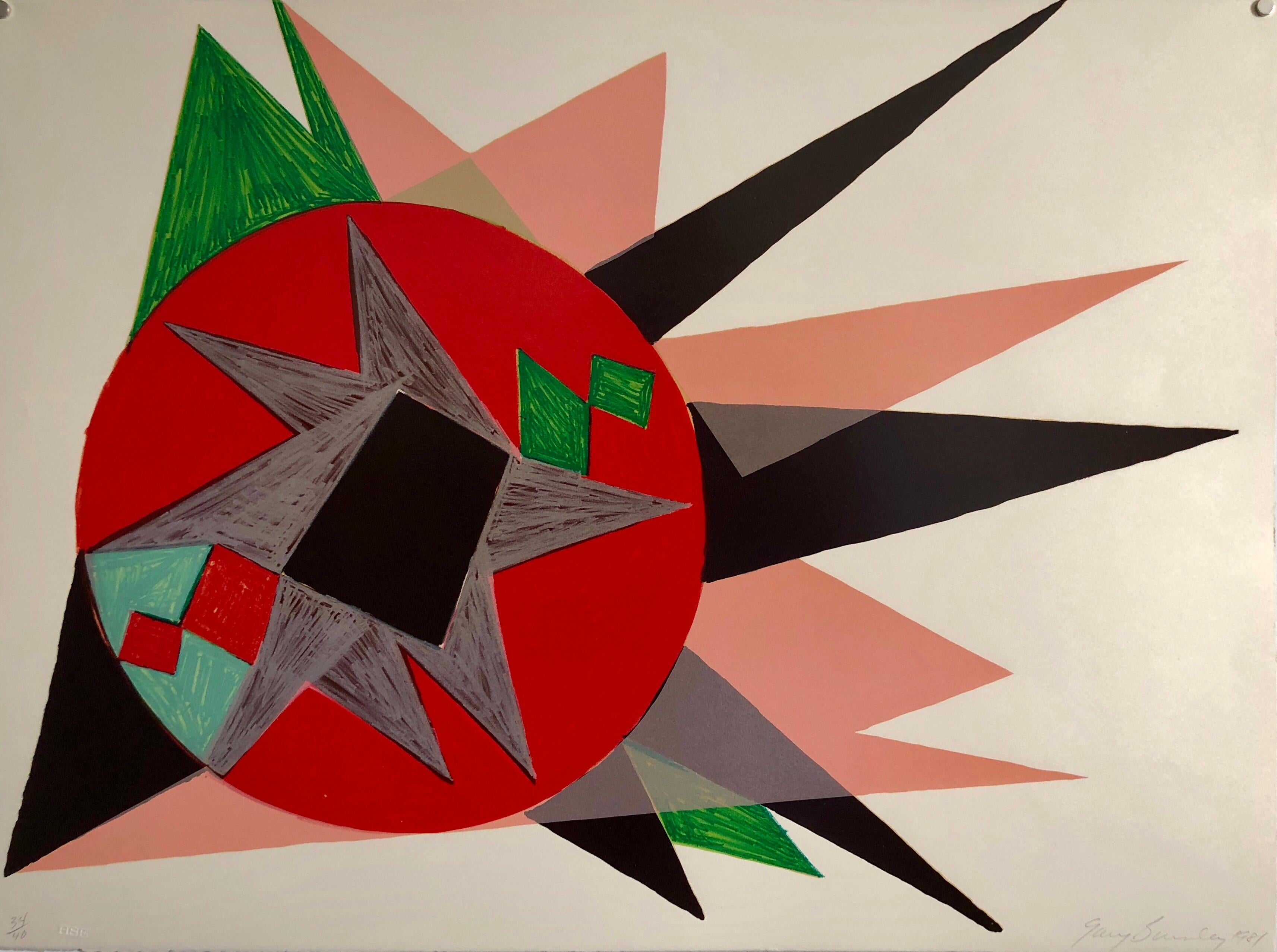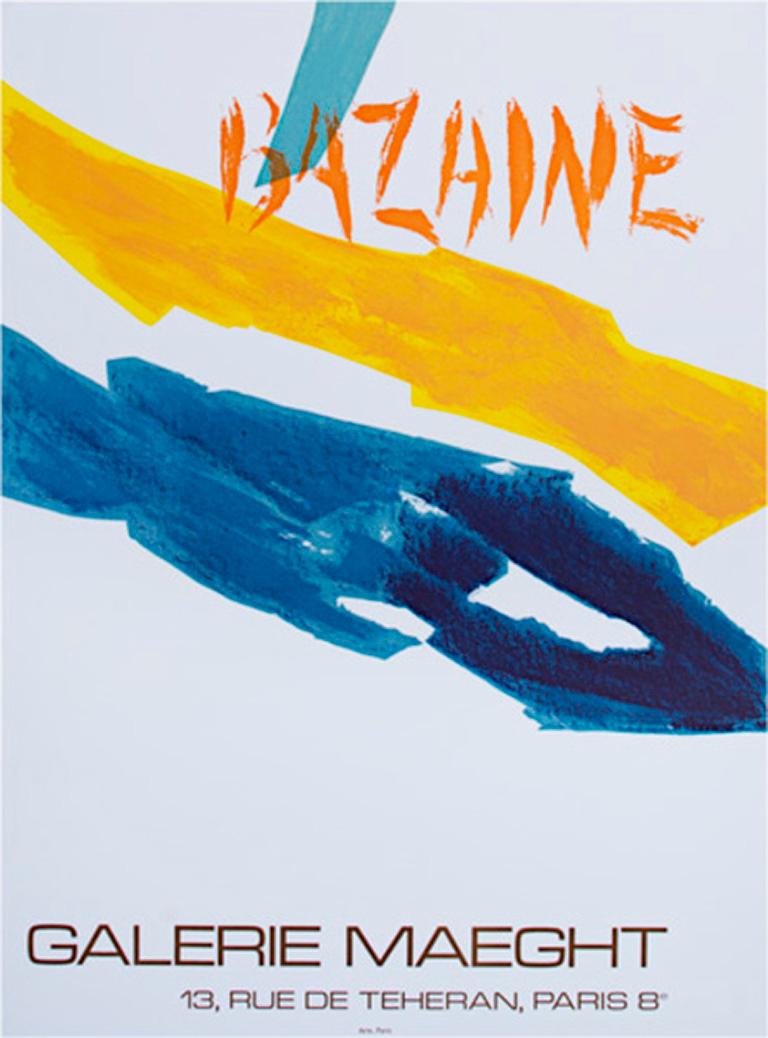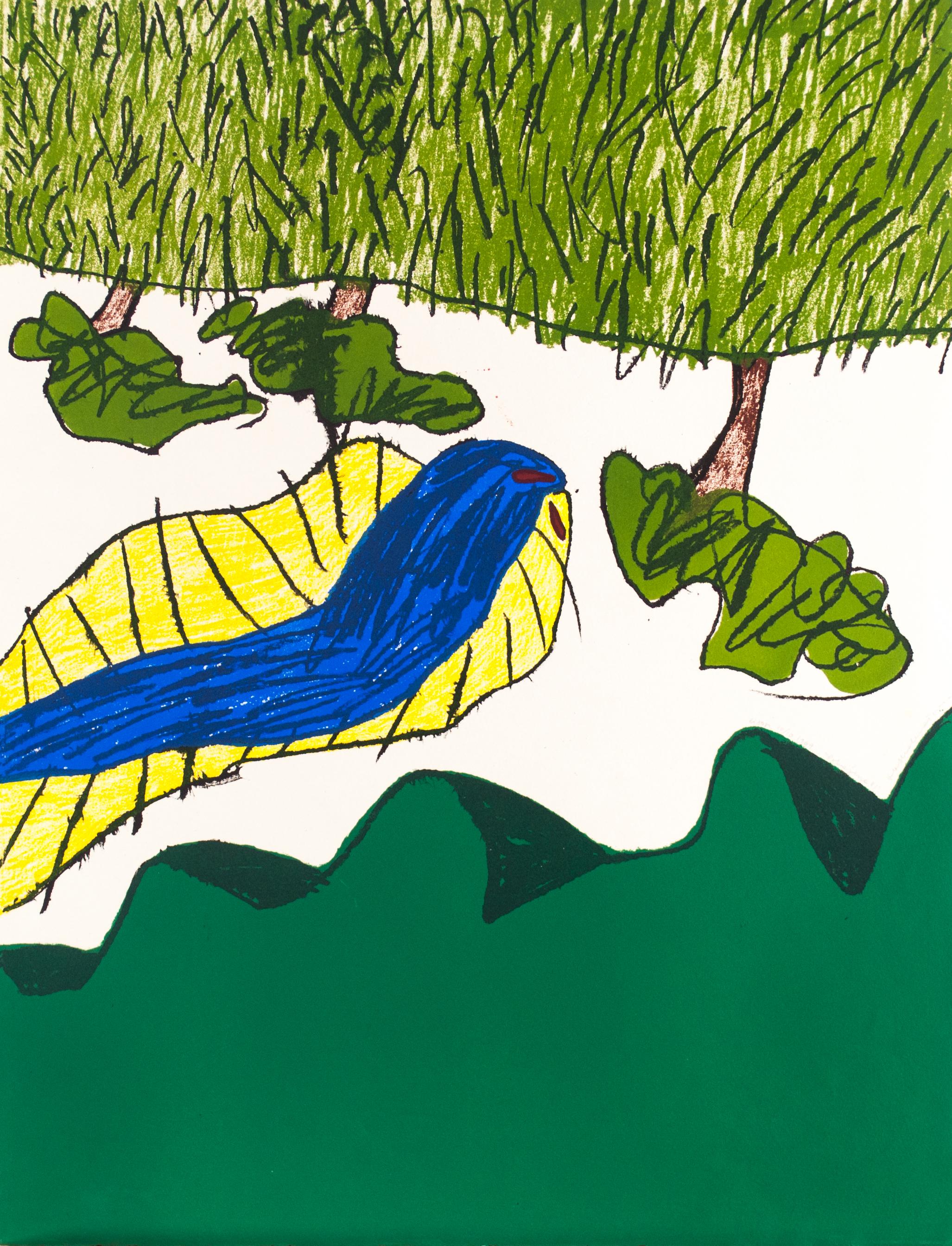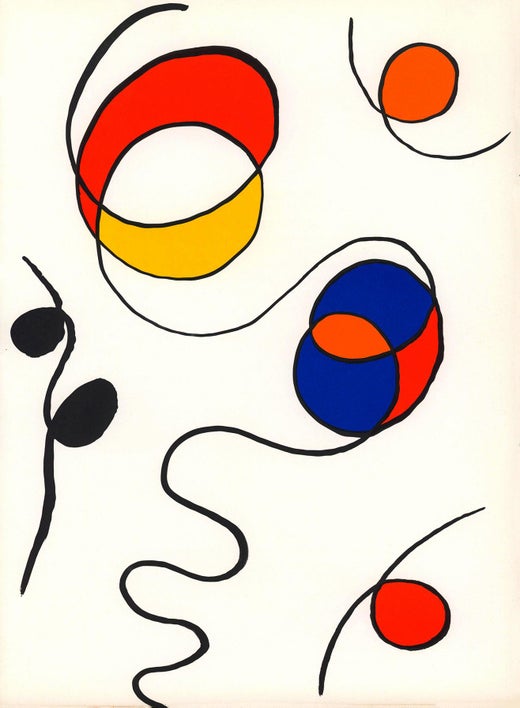Alexander Calder"Stabile with Red Sun Galerie Maeght, " Original Lithograph Poster by A. Calder1976-7
1976-7
About the Item
- Creator:Alexander Calder (1898 - 1976, American)
- Creation Year:1976-7
- Dimensions:Height: 33 in (83.82 cm)Width: 22.37 in (56.82 cm)
- Medium:
- Movement & Style:
- Period:
- Condition:
- Gallery Location:Milwaukee, WI
- Reference Number:
Alexander Calder
The American sculptor Alexander Calder is known as the father of the mobile, a moving artwork composed of delicately balanced sculptural forms suspended from the ceiling.
Because Calder's parents, both artists themselves, did not want him to suffer the hardships of trying to make a living in art, they encouraged the young Calder to study mechanical engineering at the Stevens Institute of Technology, in Hoboken, New Jersey. He worked a number of jobs, including as a hydraulic engineer and draftsman for the New York Edison Company, before deciding to pursue an artistic career. He never abandoned his engineering background, however, applying his understanding of gears and moving parts in all his artworks, from mechanical toys like the Cirque Calder (1931) and his revered prints to his free-standing abstract sculptures, called stabiles.
In 1926, Calder moved to Paris and established a studio in the Montparnasse quarter. He began creating the many parts of his famous miniature circus from found materials, such as wire, string, cloth, rubber and cork. Designed to be transportable, Cirque grew to fill five suitcases over the years. Always interested in putting forms in motion, Calder also pioneered a new art form called wire sculptures, which he described as “drawings in space.” Like his famous mobiles, the wire sculptures were suspended so that they turned with any movement of the air, presenting different forms when viewed from different angles.
In the 1950s, Calder returned to his roots in mechanical engineering, creating monumental abstract sculptures that verged on the architectural. He worked from loose gestural drawings like this preparatory sketch for his Man Stabile, from 1966. Throughout his career, he also worked as a set designer for the theater, as well as an illustrator and printmaker, producing vibrant, whimsical drawings for books and journals.
Find original Alexander Calder art today on 1stDibs.
- ShippingRetrieving quote...Ships From: Milwaukee, WI
- Return PolicyA return for this item may be initiated within 14 days of delivery.
- "Galerie Maeght, " Graphic Color Lines Lithograph Poster by Jean Rene BazaineLocated in Milwaukee, WI"Galerie Maeght" lithograph poster by Jean Rene Bazaine. This poster holds Bazine's name in harsh orange lines near the top of the piece. Diagonally bisecting the b and a in Bazaine is a teal line. Bellow this horizontally against the white backgrounds are two lines, one painted yellow and the other blue. Image: 29 x 21 in Jean Bazaine was a French painter, designer of stained glass windows, and writer. He was the great great grandson of the English Court portraitist Sir George Hayter. In 1949/1950 he had his first major one man show at the Galerie Maeght, who remained his art dealer thenceforth. From then on it was a steady progress of major exhibitions: Bern, Hanover, Zürich, Oslo... 1987 a retrospective exhibition in Galerie Maeght, 1988 a retrospective of his drawings in the Musée Matisse and finally in 1990 the Exposition Bazaine in the Galeries Nationales du Grand Palais, Paris., which was accompanied by the reissue of his major texts on painting in art theory as Le temps de la peinture (Paris, Aubier 1990). "The motley crowds of international tourists and souvenir-shoppers who fill the ancient streets of the Latin Quarter in Paris spend most of their time admiring the open-air displays of seafood outside the Greek restaurants in the rue de la Huchette. They ignore the beautiful church of St Severin in the same street, for have they not already "done" Notre Dame? So they miss one of the most wonderful series of stained-glass windows in France: Jean Bazaine's vivid, dynamic works irradiating the sombre ambulatory and apsidal chapels. These windows represent the seven sacraments of the Church, portrayed as essential forms from nature in all its glory and symbolising Water, Fire and Light, sacred emblems of Divine Grace. An appropriate biblical verse is inscribed beneath each. Only Pierre Soulages with his "luminous black" windows at l'Abbaye de Conques (1998) can stand comparison with the majesty of these contemporary works by Bazaine, created between 1965 and 1970. Bazaine was fortunate in his friends. He received at an early stage in his student career support and advice from another master colourist, Pierre Bonnard. In his youth he knew Leger, Braque, James Joyce and Marcel Proust. One of his great personal friends was Jean Fautrier, with whom he shared his first exhibition in 1930. His work gradually developed as a form of bold tachisme - brilliantly composed but well-controlled "splashes" of sumptuous colour. He rejected the term "abstract" which he considered a denial of the essentially intimate relationships between art and reality. He quoted his friend Braque: "The canvas must efface the idea behind it." In 1941, during the Nazi occupation, at a time when Hitler was destroying many works of modern art, Bazaine had the courage to organise in Paris a first "avant-garde" exhibition of 20 French artists. In 1948, he wrote his first book, an unpedantic, unacademic view of contemporary painting, Notes sur la peinture d'aujourd'hui. He quotes Braque on Cezanne: "He's a painters' painter - other people think it's unfinished." Bazaine, too, reverenced Cezanne: Three lines drawn by Cezanne overturn our whole concept of the world, proclaim the liberty of man, his courage. The great painters have never had any other aims. The painter says: "I exist, therefore you exist. I am free, therefore you are free. Or at least he tries to. It's his one aim in life." After the Second World War, Bazaine produced vast compositions with virtuoso colour structures, mostly with references to nature, like the breathtaking Vent de mer (1949, now in the Museum of Modern Art, Paris) and Orage au jardin (1952, now in the Van Abbemuseum at Eindhoven). His Earth and Sky (1950) is in the Maeght Foundation at Saint Paul de Vence. One of his greatest works, L'Arbre tenebreux (1962), was sold to the Sonja Henie...Category
1970s Post-Modern Abstract Prints
MaterialsLithograph
- "Butter Bug, " Original Etching by Nicolee TeegardenLocated in Milwaukee, WI"Butter Bug" is an original etching by Nicolee Teegarden. This piece features abstract, biomorphic swirls in black and white. 9" x 5" art 17" x 14" frame Taught art at Tremper Hig...Category
1970s Post-Modern Abstract Prints
MaterialsEtching
- "Don't Wine, " Original Surreal Serigraph by Paula Schuette Kraemer & Bill WeegeBy Paula Schuette KraemerLocated in Milwaukee, WI"Don't Wine" is a mixed media piece, predominately a serigraph, by Paula Schuette Kramer and Bill Weege. Both artists signed in pencil in the lower right, and the title is in the lower left. It is one of a an edition of 50. The print is an explosion of bright colors, but red, blue, and green dominated the composition as they fade through the background. A blue figure climbs up a ladder out of an apple, hefting a large wine bottle overhead, which they pour out into the sea of wine. A man, woman, and long-necked orange bird also look out from the apple, reading for the stem of a floating bunch of green grapes. A group surrounds the grapes with their heads and shoulders above the water, eating the fruit. Birds fly through the background, dodging wine glasses and a vase of flowers that seem to be tumbling from a flying carpet. The entire image feels very surreal. Art size: 12" x 10" Frame size: 19 1/4" x 17" Paula Schuette Kraemer is an independent artist living in Madison, Wisconsin...Category
1990s Post-Modern Abstract Prints
MaterialsMixed Media
- Original Lithograph VI, from Miro Lithographs II, Maeght Publisher by Joan MiróBy Joan MiróLocated in Milwaukee, WI"Original Lithograph VI" is an original color lithograph by Joan Miro, published in "Miro Lithographs II, Maeght Publisher" in 1975. It depicts Miro's signature biomorphic abstract s...Category
1970s Abstract Abstract Prints
MaterialsLithograph
- Original Lithograph V, from Miro Lithographs III, Maeght Publisher by Joan MiróBy Joan MiróLocated in Milwaukee, WI"Original Lithograph V" is an original color lithograph by Joan Miro, published in "Miro Lithographs III, Maeght Publisher" in 1977. It depicts Mir...Category
1970s Abstract Abstract Prints
MaterialsLithograph
- 'Oasis' signed color lithograph (2/10)By Joseph RozmanLocated in Milwaukee, WIArt: 11-1/4 x 11-7/8 Color lithograph, signed (2/10) Joseph Rozman was born on December 26, 1944 in Milwaukee, WI. He was the first artist to have a solo exhibition at the David Barnett Gallery...Category
1960s Abstract Prints
MaterialsLithograph
- The Songs of the Blacks and the BluesBy Louise BourgeoisLocated in Ljubljana, SIThe Songs of the Blacks and the Blues. Original color lithograph, woodcut, gouache and oil-stick editions, 1996. Edition of 40 signed and numbered impressions on Arches paper. Louise...Category
1990s Post-Modern Abstract Prints
MaterialsMixed Media, Gouache, Lithograph, Woodcut
- Italian Post Modern Pop Art Lithograph Silkscreen Valerio Adami Galerie MaeghtBy Valerio AdamiLocated in Surfside, FLTitled Ledoux, color limited edition lithograph. Hand signed by artist in pencil to right hand corner, 101/150 to left. 19.5" X 14" print view area. This is done in a Postmodernist, Memphis Milano style. Valerio Adami (born 17 March 1935) is an Italian painter. Educated at the Accademia di Brera in Milan, he has since worked in both London and Paris. His art is influenced by Pop Art. Adami was born in Bologna. In 1945, at the age of ten, he began to study painting under the instruction of Felice Carena. He was accepted into the Brera Academy (Accademia di Brera) in 1951, and there studied as a draughtsman until 1954 in the studio of Achille Funi. In 1955 he went to Paris, where he met and was influenced by Roberto Matta and Wifredo Lam. His first solo exhibition came in 1959 in Milan. In his early career, Adami's works were expressionistic, but by the time of his second exhibition in 1964 at Kassel, he had developed a style of painting reminiscent of French cloisonnism, featuring regions of flat color bordered by black lines. Unlike Gauguin, however, Adami's subjects were highly stylized and often presented in fragments. In the 1970s, Adami began to address politics in his art, and incorporated subject matter such as modern European history, literature, philosophy, and mythology. In 1971, he and his brother Giancarlo created the film Vacances dans le désert. In 1974 he illustrated a Helmut Heissenbuttel poem, Occasional Poem No. 27. Ten Lessons on the Reich with ten original lithographs {Galerie Maeght}. In 1975, the philosopher Jacques Derrida devoted a long essay, "+R: Into the Bargain", to Adami's work, using an exhibition of Adami's drawings as a pretext to discuss the function of "the letter and the proper name in painting", with reference to "narration, technical reproduction, ideology, the phoneme, the biographeme, and politics". The Galerie Maeght is a gallery of modern art in Paris, France, and Barcelona, Catalonia, Spain. The gallery was founded in 1936 in Cannes. The Paris gallery was started in 1946 by Aimé Maeght. The artists exhibited are mainly from France and Spain. Since 1945, the gallery has presented the greatest modern artists such as Matisse, Bonnard, Braque, Miró, and Calder. In 1956, Adrien Maeght opened a new parisian venue. The second generation of “Maeght” artists was born: Bazaine, Andre Derain, Giacometti, Kelly, Raoul Ubac, then Riopelle, Antoni Tapies, Pol Bury and Adami, among others. There were four retrospective exhibits of Adami's work between 1985 and 1998. They were held in Paris, the Centre Julio-Gonzalez de Valence (Spain), Tel Aviv, and Buenos Aires. In 2010, the Boca Raton Museum of Art devoted a special exhibit to Adami's Post Modern paintings and drawings. Derriere le Miroir, the editor was Aimé Maeght. Derrière le Miroir is a French art magazine created in 1946 and published until 1982...Category
1980s Post-Modern Landscape Prints
MaterialsLithograph
- Lithograph w Gloss Overprinting Stacked Signs Post Modern 80s Memphis Milano EraLocated in Surfside, FLUntitled, 1981 (Stacked Signs Series) lithograph with Glosscote overprinting. Published by Holly Solomon Editions. (original gallery label photo is included for reference and not included in sale) Hand signed and numbered from limited edition of 40. This is a beautiful piece perfect for the Memphis Milano early 1980's Post Modern Era. It also bears influence from Pop Art (Particularly Allan D'Arcangelo) Gary Burnley...Category
1980s Post-Modern Abstract Prints
MaterialsLithograph
- Derriere le Miroir #221By Alexander CalderLocated in Washington, DCArtist: Alexander Calder Title: Derriere le Miroir #221 Portfolio: Derriere le Miroir #221 Medium: Lithograph in colors Date: 1975 Edition: Unnumbered Sheet Size: 15" x 22" Image Siz...Category
1970s Post-Modern Abstract Prints
MaterialsLithograph
- Upside downLocated in Ljubljana, SIUpside down. Original color lithograph, 1969. Edition of 10 signed and numbered impressions on Arches paper. Metka Krašovec is one of the most important painters in contemporary Slov...Category
1960s Post-Modern Abstract Prints
MaterialsLithograph
- OlympiaBy Friedensreich HundertwasserLocated in Ljubljana, SIOriginal signed color poster lithograph, 1983. Edition of 150 signed and numbered impressions on Arches paper. Art and Sport portfolio: The Yugoslav Olympic Committee of the Winter O...Category
1980s Post-Modern Abstract Prints
MaterialsLithograph
Recently Viewed
View AllRead More
Renowned for His Mobiles, Alexander Calder Was Also Adept at Crafting Modernist Jewelry
There are no sparkling gemstones on this necklace, but its value far exceeds the cost of its materials.
10 Must-Visit American Public Sculptures
Get your dose of Vitamin D while surveying works by the likes of Alexander Calder, Keith Haring and Pablo Picasso.






